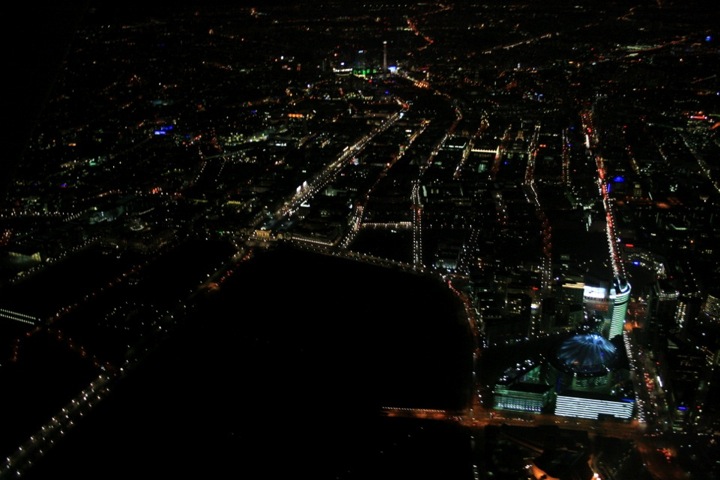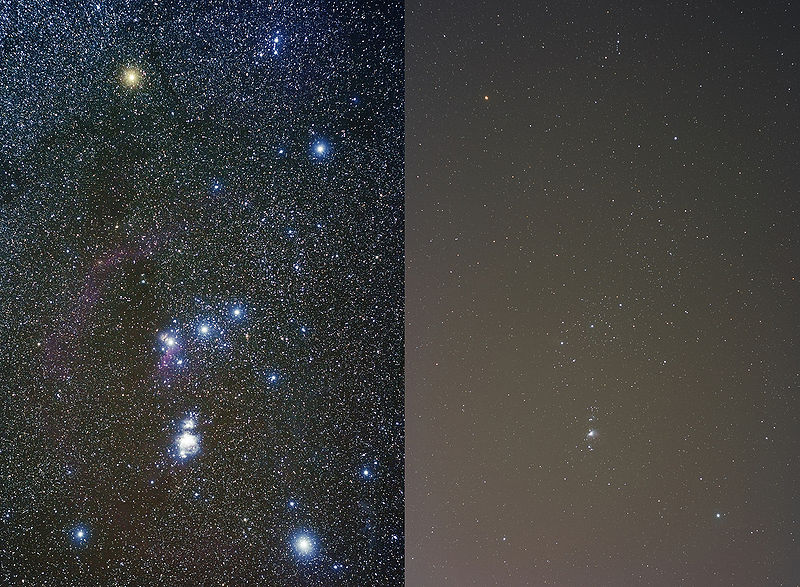Report
by Christopher Kyba
Since you’re reading this blog post, the odds are you already know that there are serious problems with the way lighting is used in industrialized societies. The odds are also good that you’d like to do something about it. But what can any one individual accomplish, when lighting decisions are made by faceless corporations and impenetrable city bureaucracy? The answer is – a lot!
There are two powerful factors that prevent corporations and governments from adopting excellent, modern, efficient lighting. The first factor is that they usually don’t know that they’re doing anything wrong! In the right place at the right time, a well-informed individual could have a huge influence simply by showing up to a city council meeting and explaining what is wrong with the way the city is currently lit. The second factor is that lighting has gotten progressively worse over several generations, and each new generation grows up thinking that the lighting they are used to is “normal”. Unless someone like you explains to them what’s wrong, they probably won’t realize that it’s even possible to improve the urban nighttime environment.
The battle against light pollution will only be won once a large fraction of the population can explain in their own words what is wrong with current lighting. To get from here to there, we need everyone who understands the problem to talk about it with their friends, family, and co-workers.
So how do you talk about light pollution? Here are a few good conversation starters:
Have you ever been driving at night and been blinded by a car with those bright, blue headlights?
- Blue light is more likely to be scattered inside your eye, and it’s mainly the blueness that makes these lights glaring, not their brightness. Many communities are currently switching to “white” LED streetlamps. These lamps have several nice properties, but the white LEDs with the highest luminous efficiency emit large amounts of blue light. Old-fashioned street lamps shine light down the whole block, causing a lot of glare. Unless the city chooses streetlamps carefully, they could introduce this bright-blue-light problem onto every single streetlight. This problem gets worse as you get older, so this is a major demographic concern.
Did you ever notice that you can directly see the bulbs of a lot of street lights when you’re in an airplane at night?
- When street lights shine up into the air they don’t help us see, and this wasted light costs the USA around $7 billion per year. There is a very simple solution: cities and states just need to pass a law requiring area lighting to shine only towards the area that needs to be lit.

Copyright C. Kyba 2011
Have you ever slept in a hotel room where a streetlight or billboard shone in your window? How did you sleep?
- Most people have trouble sleeping unless it’s dark. This isn’t psychological; the presence of light actually prevents your brain from making the “sleep hormone” melatonin. Many residential windows are directly lit by poorly designed streetlamps. These problems could be eliminated by appropriate legislation, and in many cases the city would actually save money by putting the light where it’s really needed.
Each of the questions above will get your conversation partner to make the case against poorly designed lighting for you. Once they are on your side, you can discuss other aspects of effective modern lighting, such as dimming lamps in quiet residential areas to 10% after midnight, and using motion sensors to turn them up again when a car or pedestrian is in the area.
Since we talked about good ways to start a conversation, let’s also talk about some terrible things to bring up…
Did you know that light pollution prevents 70% of the population of the USA from seeing the Milky Way?
- I care about this, and you probably do too. But you can’t miss what you’ve never seen, and in most cases your conversation partner hasn’t experienced the Milky Way in years (if ever). This is only something to talk about once they’re already on the bandwagon.

Image from Wikimedia commons by Jeremy Stanley.
I hate that [beloved local landmark] is lit up all night, don’t you?
- Architectural lighting is often terrible, but our studies indicate that lighting for historical buildings makes up only 0.09% of all zenith directed light in Berlin. You are much more likely to get someone on your side by attacking the lighting they don’t like, rather than the lighting they think is beautiful. I think there is a good case to be made for turning off architectural lighting after a certain hour, or restricting it to special events, but this isn’t as important as modernizing area lighting.

Copyright 2011 C. Kyba
We need to dim or turn off lights to save energy and money, and it’s not a problem because lighting doesn’t prevent crime.
- Your conversation partner might want to discuss crime, so you should be ready to tell them that if light has an effect on crime it’s so small that statisticians can’t detect it. So why bother bringing it up yourself? If it comes up, ask your partner what makes more sense: shining light uselessly up into space, or using the money saved after modernization to hire more police?
Poorly designed lighting kills uncountable numbers of insects.
- If you say this, be prepared to hear “great, I hate bugs anyway”. If your friend is an environmentalist or loves birds, then by all means talk to them about how artificial light affects animals. Great examples are the millions of birds killed by poorly lit buildings and towers, and the terribly sad story of the poor baby sea turtles. But I think most people will respond much more strongly to a discussion about how bad lighting affects them personally than about how it affects animals they rarely (if ever) see.

Distributed by Fir0002/Flagstaffotos under the Gnu Free Documentation License v1.2
Now that your friend recognizes that there is something wrong with the way cities are lit today, you need to get them to do something about it. Invite them to become a member of the International Dark Sky Association. As an IDA member, they will learn more about how to improve lighting in their community, and their membership fees will help IDA produce outreach materials and assist communities that want to install effective modern lighting.
With the efforts of people like you, we’ll all soon enjoy lower taxes, a smaller carbon footprint, improved visibility at night, darker bedrooms, and, oh yeah, more stars in our skies!
###
 Christopher Kyba studies artificial light at night at the Freie Universität in Berlin, Germany. He was elected to the board of directors of the IDA in 2012.
Christopher Kyba studies artificial light at night at the Freie Universität in Berlin, Germany. He was elected to the board of directors of the IDA in 2012.
- A good picture of the Brandenberg Gate,Berlin,lit up at night yet given the amount of daylight hours people have to view these structures is it worth lighting them up considering the damage that the lighting does but to the night sky and in carbon emmisions?I was in Scotland late last year travelling over the Forth Bridge near Edinburgh and saw the huge floodlights they have to illuminate the bridge what I call vanity lighting most of this light will end up flooding into the night sky,Its worse with objects like the Forth Bridge or Eifel Tower as theyre not solid most light passes on and upwards.







 kevan hubbard
kevan hubbard
Comments